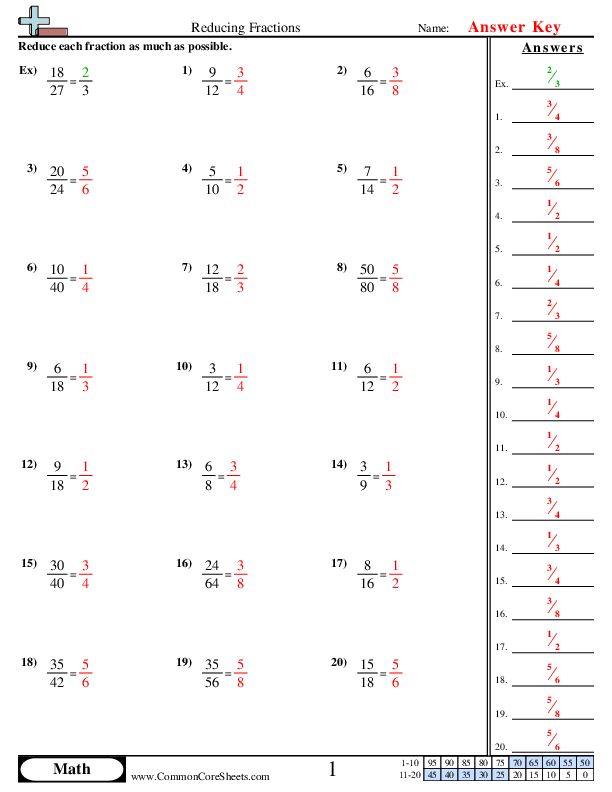Our fraction worksheets are the best on the internet! These free worksheets are perfect for students of all ages who are learning or reviewing fractions. Our fraction worksheets cover a range of skills, from simplifying fractions to adding and subtracting fractions with different denominators. Each worksheet includes clear instructions and plenty of space for students to show their work. With our fraction worksheets, you'll find everything you need to help your students master this important math concept. So why wait? Try our fraction worksheets today and see why they're the best on the internet!
Browse Sheets By Problem Type
×
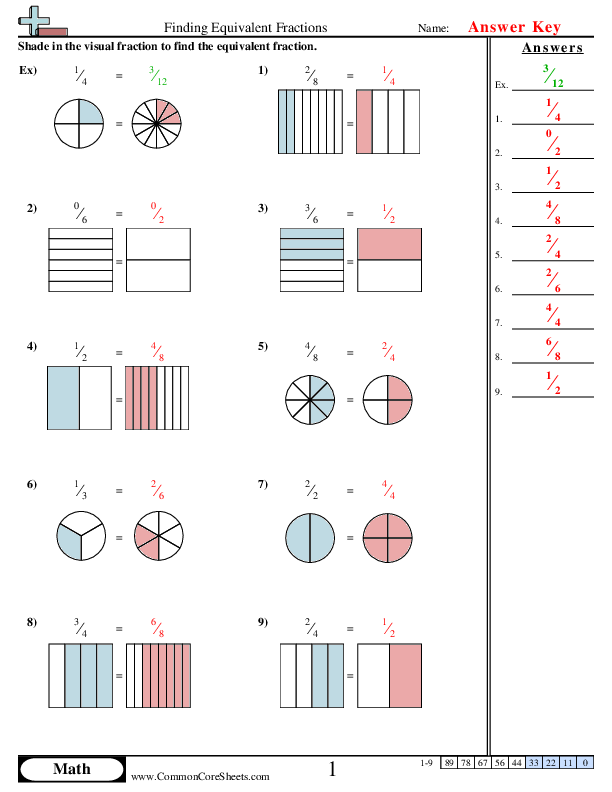
Finding Equivalent Fraction (visual)
3nf3b


×
Description:
"This worksheet is designed to help children understand the concept of equivalent fractions in mathematics, using visually-appealing and clear examples. With 9 problems to solve, learners can engage in a hands-on approach to mastering this fundamental math topic. It offers multiple options as it can be customized to meet the learner's pace, converted into convenient flashcards for revision purposes, or seamlessly integrated into distance learning curriculums. This innovative learning tool merges fun and education."

×
Student Goals:
Understanding Equivalent FractionsUpon successfully completing the worksheet, students should have a comprehensive grasp on equivalent fractions. The ability to confidently identify and develop equivalent fractions is a fundamental part of progressing in the understanding of math. As equivalent fractions hold the same value, despite their different appearances, navigating the intricacies of their relationships is essential.Improving Fraction SimplificationThe presented problems on the worksheet incrementally introduce students to fraction simplification. By reinforcing the underlying principles of reducing fractions to their simplest form, pupils will improve their fraction simplifying abilities. This consolidates their knowledge of fractions in general, building a solid foundation for more advanced mathematical problems.Developing Skills in Problem SolvingExposed to a range of problems, the children will hone their problem-solving skills. The ability to approach questions from different angles is a key objective of this worksheet. Beyond mathematical proficiency, this skill is crucial for general learning and grappling with complex issues across various subjects.Increasing Confidence in Handling FractionsChildren will gain confidence in handling fractions, thereby reducing numeracy anxiety and improving academic performance. With proficiency in dealing with fractions, students should feel comfortable with numerical concepts, encouraging overall engagement in studying mathematics.Promoting Mathematical ReasoningThis exercise promotes the pupil's mathematical reasoning, nurturing their ability to identify patterns and relationships between numbers. The workbook serves to help students make links between different areas of mathematics, contributing to comprehensive and diverse mathematical proficiency.Enhancing Numerical FluencyGradual exposure to and practice of these problems will enhance student’s numerical fluency. With the visualization and normalization of fraction problems included, children will naturally begin to recognize common fraction problems and correlations between different fractions, promoting a stronger sense of number sense and ease with distinguishing numerical values.



Equivalent Fractions With Numberlines
3nf3a


×
Description:
"This worksheet is designed to help children understand and find equivalent fractions using number lines. By presenting eight diverse problems, it aids in converting abstract fraction concepts into visible representations. Each problem encourages the identification of equivalent fractions, fostering a solid grip on basic mathematical principles. Customizable for differing learning levels, this worksheet is an excellent resource for distance learning and can readily be transformed into flashcards for interactive education."

×
Student Goals:
Understanding Basic Fractions ConceptsAfter completing this worksheet, students should have a deep understanding of fundamental fraction concepts. They should be able to clearly define fractions and their parts (numerator and denominator), know how to ascertain fractions on a number line, and comprehend how fractions relate to the concept of division and portions.Develop Skill in Finding Equivalent FractionsStudents will acquire the crucial skill of determining equivalent fractions. Equivalent fractions are fractions that, despite having different numerators and denominators, represent the same proportion of a whole. By comparing fractions on a number line, students can visually interpret and identify equivalent fractions, thus reinforcing this key mathematical concept.Enhance Problem-Solving SkillsBy working on the worksheet, students will enhance their problem-solving skills, critical in mathematics. They should be capable of using established strategies (like using a number line) to solve a problem, analyze and interpret their results, and adjust their methods if necessary, thereby boosting their problem-solving abilities and cultivating mathematical thought.Improve Number SenseCompleting problems involving equivalent fractions on a number line will help students to establish better number sense. Number sense, the understanding of number relationships and the ability to make logical decisions about numbers, is a crucial part of early math learning. Students should have improved their ability to visualize and comprehend how numbers, particularly fractions, fit together.Foster Precision and AccuracyStudents should have cultivated precision and accuracy in their mathematical workings. From setting out their solutions neatly, to correctly positioning fractions on a number line, to accurately determining equivalent fractions - this worksheet will have taught the students to value accuracy in their computations and representations, a critical skill for more advanced math work.Promote Autonomy in LearningLastly, the worksheet encourages students to take charge of their learning by working independently. They should be able to complete similar exercises on their own, using the techniques and comprehension they've developed, fostering an attitude of self-reliance and confidence in their math abilities.


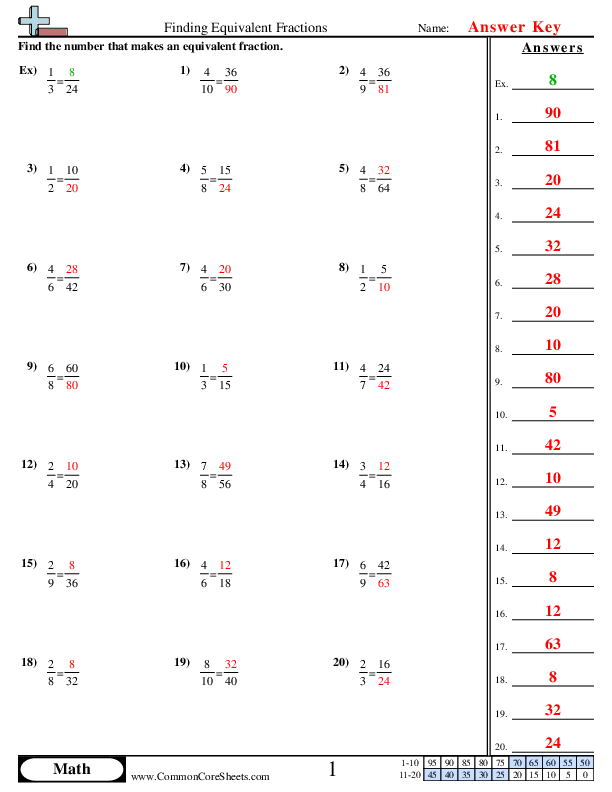
Equivalent Fractions (Missing Number)
4nf1


×
Description:
"This worksheet is designed to help children grasp the concept of equivalent fractions in math. It features 20 interactive problems, with examples such as 1/6 equals 2/12, 7/9 equals 28/36, and 3/6 equals 30/60. Perfect for distance learning, the worksheet can be customized for individual needs and even converted into flashcards to further facilitate understanding. Enhance your child's math skills through this engaging and adaptable tool."

×
Student Goals:
Understanding Equivalent FractionsAfter completing this worksheet, students should have a strong understanding of equivalent fractions. This fundamental concept in mathematics is critical as it underpins many more complex areas of study within the subject. By practicing to find equivalent fractions, students improve their problem-solving abilities and enhance their mathematical reasoning.Enhancing Calculation SkillsWorking through the worksheet will also help students to refine their calculation skills, especially their division and multiplication abilities. By repeatedly identifying equivalent fractions, students will become more fluent and confident in performing these calculations, helping them to improve their overall math competency.Improving Number SenseThe worksheet encourages the development of a strong number sense, which is the understanding of what numbers mean and their relationship to one another. By finding equivalent fractions, students will actively explore the relationships between numbers, leading to a deeper comprehension of mathematics.Developing Pattern RecognitionAs students work through the problems in the worksheet, they will also have opportunities to recognize and predict patterns. This is an important mathematical skill that will support them in diverse areas of study, such as algebra and geometry.Applying Mathematical ConceptsAt the completion of the worksheet, students will not only have bolstered their understanding of equivalent fractions but will also have enhanced their ability to apply this knowledge. Whether solving more complex mathematical problems or using these skills in real-world situations, they will be equipped with a crucial knowledge base, helping them excel in future learning endeavors.Building ConfidenceFinally, with each problem they successfully solve, students are building their confidence in solving mathematical problems. Overcoming challenges faced in this worksheet can foster perseverance and resilience, which are beneficial not just for math but for every aspect of their learning journey.


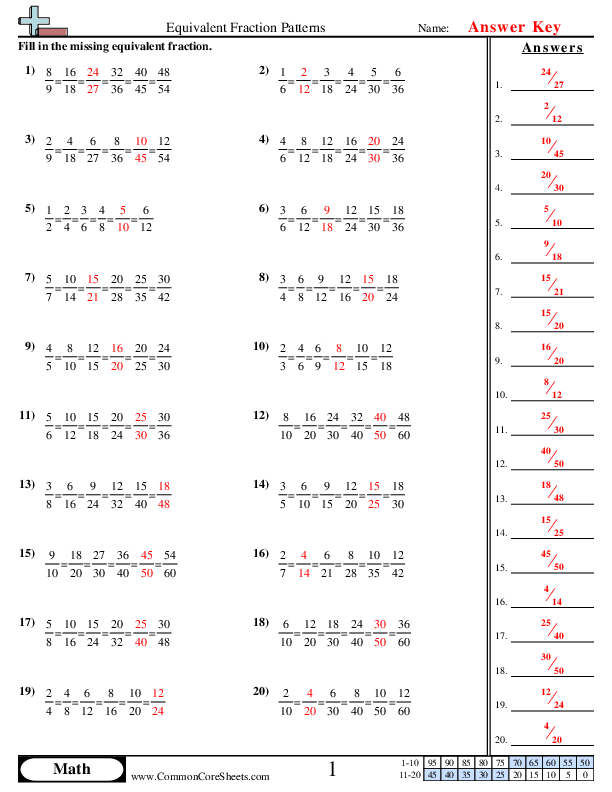
Filling in a pattern
4nf1


×
Description:
"This worksheet is designed to teach children about equivalent fractions through pattern recognition in math. It features 20 unique problems, where fraction equivalencies are visually represented in table format. The interactive nature of the content allows for customization, including the capacity to convert the worksheet into flash cards. This feature extends its usability, making it an excellent tool for distance learning and homeschooling environments."

×
Student Goals:
Understand Equivalent FractionsWith successful completion of this worksheet, students should develop a solid understanding of equivalent fractions. They should be able to recognize that different fractions can represent the same part of a whole, enhancing their numerical flexibility. This forms the basis for strong mathematical reasoning, feeding into other areas of number theory and arithmetic.Develop Problem-Solving SkillsThese carefully designed fraction problems should help students strengthen their problem-solving skills. By unraveling patterns and deducing the correct numerical value for each equivalent fraction, students exercise both inductive and deductive reasoning, preparing them for advanced math hurdles. This process refines their decision-making skills, teaching them to strategize and choose the most efficient route to a solution.Enhance Mental ArithmeticBeing repeatedly exposed to and working on these fraction problems will enhance students' mental arithmetic. They will be more comfortable and quicker at processing numbers mentally, which will be fruitful not just in mathematics, but across all subjects and day-to-day applications, increasing their number sense.Grasp Number PropertiesCompletion of this worksheet should aid students in grasping the properties of numbers, and how they interact in the context of fractions. They will have gained an understanding of the important mathematical concepts of ratio and proportion, thus extending their knowledge of numbers and paving the way for future mathematical learning.Application to Real-life SituationsThe learning attained from this worksheet extends beyond the classroom. It enables students to apply their knowledge to real-life situations. As fractions are ubiquitous in daily life scenarios, for instance, during cooking, shopping or time allocation in daily activities, comprehension of equivalent fractions can enhance practical problem-solving skills, empowering students to make accurate and efficient calculations.Builds a Foundation for Advanced MathUnderstanding fractions and equivalences, a subject matter of this worksheet, represents an essential mathematical concept that underlies more advanced topics. Successful completion will provide a solid foundation for future learning in fractions, decimals, pecentage calculations, algebra and even calculus. This core mathematical competency plays a crucial role in preparing students for advanced mathematical concepts and procedures.


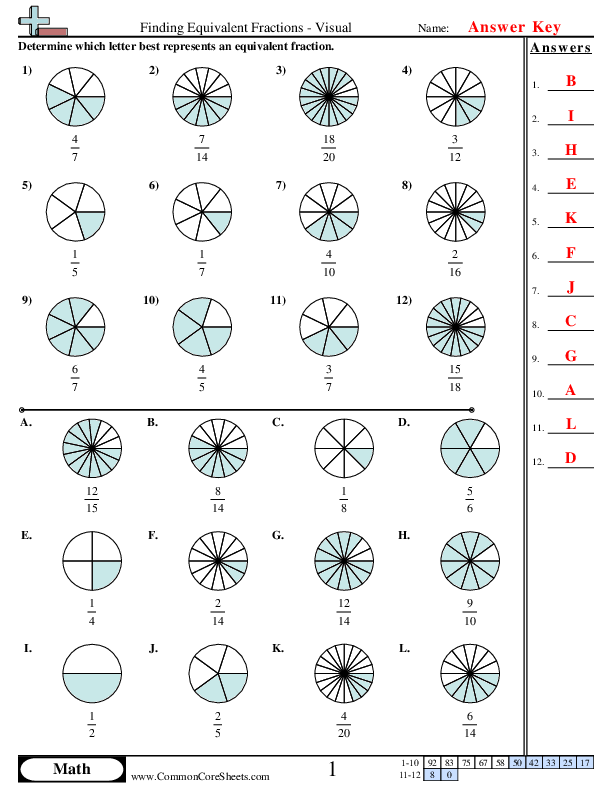
Finding Equivalent Fractions - Visual
4nf1


×
Description:
"This worksheet is designed to help children visually understand the concept of equivalent fractions in math. It provides 12 problems using vibrant diagrams to represent fractions and engage the student's interest. The flexible format allows it to be customized according to individual needs, converted into flashcards for easy review, or used in a distance learning setup to provide interactive math learning from home."

×
Student Goals:
Mastering Equivalent Fractions ConceptAfter successfully completing this worksheet, students should be able to confidently understand and demonstrate their knowledge of equivalent fractions. They will have gained much practice in finding equivalent fractions through visual aids which would significantly improve their skills. This worksheet is designed to aid them in visualizing what equivalent fractions look like, and how different fractions can represent the same value.Developing Problem-Solving AbilitiesSolving the problems presented in this worksheet would require students to engage their problem-solving skills. They will need to evaluate, analyze, and identify equivalent fractions. This worksheet will help enhance their cognitive development, fostering growth in analytical thinking and ability to recognize patterns. Over time, this will enhance the student's proficiency in working with other complex math problems.Boosting Confidence in MathMath can seem daunting to many students. However, having the ability to comfortably work through problems and see improvements serves as a confidence booster. As students find more success in dealing with these fraction problems, their confidence in their math skills is likely to increase. This, in turn, may foster a positive attitude towards learning and mastering other math topics.Application of Learned SkillsAfter completing the worksheet, students should be able to apply the skills they have learned to practical situations. The understanding of equivalent fractions can be used to simplify fractions or compare them. Moreover, they could apply these concepts when dealing with problems involving ratios, proportions, or probability, which they will encounter in more advanced math subjects.Fostering Self-Reliance and IndependenceThis worksheet is designed to promote self-reliance and independence. Students will find that they can work through the problems at their own pace, enhancing their ability to learn independently. This is a crucial lifelong learning skill that is applicable in many aspects of life beyond the classroom.



Creating Equivalent Unit Fraction Problems
4nf4b


×
Description:
"This worksheet is designed to enhance children's understanding of equivalent unit fractions in mathematics. It includes 20 problems, providing examples of multiplication with fractions to produce equivalent unit fractions. The dynamic and adaptable format allows it to be customized according to individual learning needs: it can be transformed into flashcards for easy revision or seamlessly integrated into distance learning modules. A practical and versatile tool for reinforcing key mathematical concepts."

×
Student Goals:
Understanding of Unit FractionsStudents will gain a solid understanding of unit fractions. They will be able to define what a unit fraction is and identify it when it is presented in a mathematical problem.Mathematical Operations with Unit FractionsAfter completing the worksheet, students would have practiced various mathematical operations involving unit fractions. They will be adept at multiplying whole numbers with unit fractions and simplify the results. They will also be proficient in expressing product of whole numbers and fractions as a product of a whole number and a unit fraction using properties of operations.Problem Solving SkillsThe worksheet will improve students' problem-solving skills, making them confident to tackle similar problems on their own. By applying their knowledge of unit fractions to a set of unique mathematical problems, they will develop the ability to implement appropriate solving strategies.Accuracy and PrecisionBy engaging with 20 unique unit fraction problems, students will improve their accuracy and precision in their mathematical work. The repetitive practice will enhance their ability to calculate correctly, minimizing any mistakes.Readiness for Advanced Math ConceptsUpon completion of the worksheet, students will be ready to take on more advanced mathematical concepts. The foundation built through understanding and applying unit fractions will be helpful in understanding more complex ideas such as higher-level fractions, decimals, ratios and percentages.Increased Mathematical ConfidenceOnce students have successfully solved all 20 problems, their confidence in their own mathematical abilities would have significantly improved. This confidence can encourage a positive attitude towards math, reducing any related anxiety and enhancing overall academic performance.



Redistributing Mixed Improper Fractions


×
Description:
"This worksheet is designed to enhance children's understanding of math by redistributing mixed number improper fractions. It features 20 problems with varying degrees of complexity, each revolving around a unique challenge in fraction conversion. Its flexible design allows it to be customized, transformed into flashcards, or integrated into distance learning for a versatile and comprehensive learning experience."

×
Student Goals:
Comprehension of Mixed Number and Improper FractionsAfter completing the worksheet, students should have a solid understanding of mixed numbers and improper fractions, appreciating how the two are deeply interconnected. They will be adept at converting between the two forms, enhancing their flexibility in numerical manipulation.Enhancement of Calculation SkillsThe completion of the worksheet will also aid in significantly improving students' calculation skills. As they work through the problems, they will be utilizing and bolstering fundamental arithmetical operations such as division which forms an integral part of numerical comprehension.Problem-solving AbilitiesThe worksheet will foster students' problem-solving skills. The nature of the problems will challenge students to apply learned concepts innovatively, stimulating their logical reasoning skills. This acquired prowess will equip them to tackle more complex math problems going forward.Readiness for Advanced ConceptsThe grounding in mixed numbers and improper fractions will prepare students to grasp more advanced mathematical concepts. Since fractions form a cornerstone of numerous complex ideas in mathematics, mastering them will aid students in understanding these subsequent topics without struggling.Familiarity with Math TerminologyCompletion of the worksheet will provide students with a familiarity of terminology used in arithmetic and number theory. Terms like numerator, denominator, mixed number, and improper fraction will become part of their regular vocabulary, aiding further mathematical learning.Confidence in Dealing with FractionsBy working through these problems, students will gain a sense of confidence and accomplishment in dealing with fractions. This instilled confidence will motivate them to approach future mathematical challenges positively, fostering a love for learning and comprehension in them.


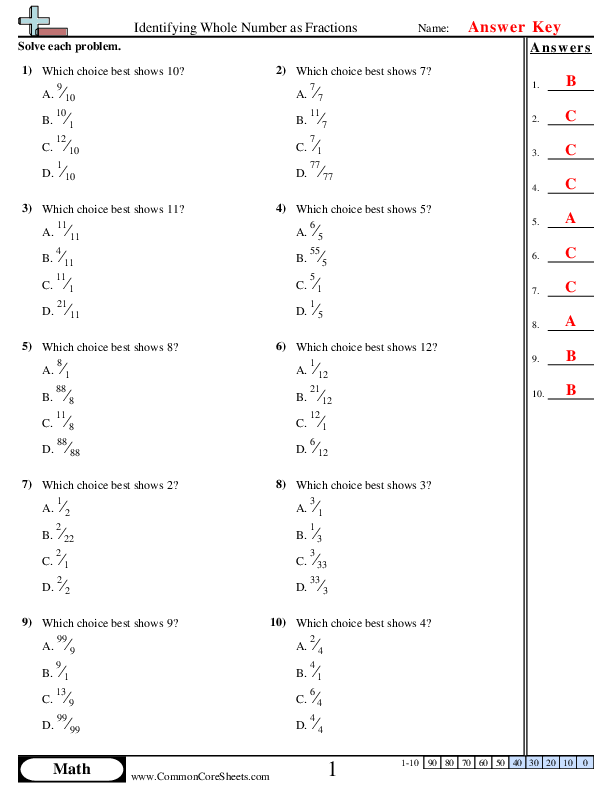
Identifying Whole Number as Fractions
3nf3c


×
Description:
"This worksheet is designed to teach children the concept of interpreting whole numbers as fractions. With 10 interactive problems, learners are tasked to identify whole numbers represented by different fractions. Adaptable to multiple learning formats, the worksheet can be customized, transformed into flash cards, or effortlessly incorporated into distance learning programs, making math engaging and accessible for young learners."

×
Student Goals:
Understanding of FractionsUpon completion of the worksheet, students should have an enhanced understanding of fractions. They will be familiar with the concept that whole numbers can also be represented as fractions as they can identify different fractions that correspond to the same whole number. This will significantly improve their ability to manipulate and work with fractions, an essential component of mathematics.Problem-solving SkillsThis worksheet aids in developing problem-solving skills among students. They will learn to apply their mathematical knowledge to identify or select the best fractional representation of a given whole number. Through this process, students gain experience in breaking down problems and making informed decisions, thus cultivating their problem-solving abilities in general.Increased AccuracyRegular practice with such worksheets increases accuracy in handling fractions. This improved accuracy will come in handy while dealing with more complex mathematical problems later on. It will also reduce the likeliness of making errors, enhancing students' overall mathematical competence.Foundation for Advanced TopicsCompleting this worksheet lays a strong foundation for learners to understand and grasp more advanced mathematical topics. The understanding that whole numbers can also be fractions forms the basis of many complex mathematical applications and is crucial for later subjects such algebra and trigonometry.Confidence BoostSuccessfully completing this worksheet will boost students' confidence in their mathematical abilities. This confidence often translates into increased participation in class and improved performance in tests and exams. Confidence in one's mathematical abilities is crucial for academic success in this subject and can also fuel interest in learning more advanced mathematical concepts.Mathematical Language UnderstandingThis worksheet also helps students in understanding and using the mathematical language effectively. They acquire the ability to read, interpret, and write mathematical equations accurately, thus improving their mathematical communication skills.


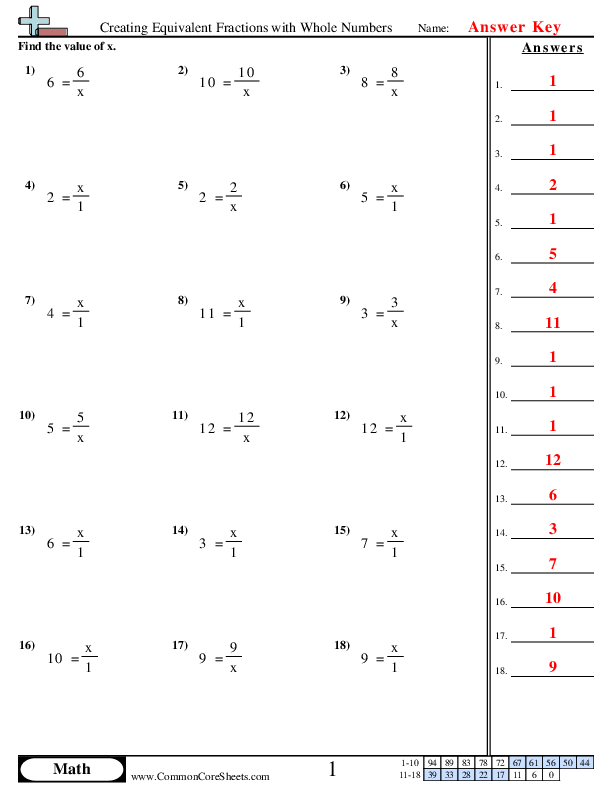
Comparing Fractions


×
Description:
"This worksheet is designed to teach children equivalent fractions using whole numbers. With 18 customizable math problems, students learn to identify proper fractions equivalent to given whole numbers. A valuable aid for distance learning, this versatile worksheet can also be converted into interactive flashcards, offering a flexible, engaging route to mastering essential math concepts."

×
Student Goals:
Understanding Equivalent FractionsUpon completion of this worksheet, students should have a solid understanding of equivalent fractions. They should be able to determine the equivalence of a whole number to a fraction by representing the whole number as the numerator and the denominator as 1. This exercise serves as a foundational learning tool for the concept of fractions as representations of whole numbers. It will provide them with tools needed for more complex fraction lessons in the future.Applying Mathematical ReasoningStudents should be able to apply their mathematical reasoning skills to solve problems accurately. They should be able to understand that whole numbers can be represented as fractions, and be able to calculate equivalent fractions. This demonstrates a knowledge of the fundamental properties of numbers and mathematical operations, formed through the practice of these worksheets.Learning Problem-Solving TechniquesAfter finishing the worksheet, learners should have gained valuable insight into techniques for solving fraction equivalencies. Methodically making sense of mathematical problems is vital in grasening the math concepts. These techniques will also be valuable when learners face more complex problems in future math lessons.Improving Computational SkillsThe worksheet should also aid in improving students' computational skills. By working through each problem, they can reinforce their knowledge of fundamental arithmetic principles. These skills are important not only in more advanced mathematics courses but also in daily life where fundamental arithmetic is commonly used.Promoting Logical ThinkingBy end of this worksheet, students should have improved their logical thinking skills, a tool vital for mathematical success. Understanding and applying the concept of equivalent fractions requires precise logical thought - an indispensable skill that goes beyond the classroom into daily decision-making scenarios.Reinforcing Consistent PracticeFinally, the conclusion of this worksheet should encourage students to understand the importance of consistent practice in mastering mathematical concepts. Tackling a good number of problems (18 in this worksheet) enables students to repeatedly apply new knowledge, invariably leading to better retention and understanding.




